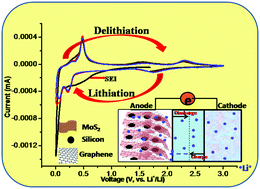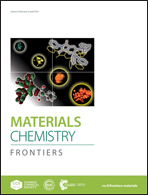Silicon nanoparticle-sandwiched ultrathin MoS2–graphene layers as an anode material for Li-ion batteries†
Abstract
Herein, we report the facile scalable synthesis of silicon (Si)/molybdenum disulfide–graphene (MoS2–G) nanocomposites with various Si/MoS2 ratios as anode materials for lithium-ion batteries (LIB). XRD studies indicated the existence of silicon, MoS2 and graphene phases. The graphene phase has been merged with the MoS2 layers. The morphological study clearly shows the presence of layered MoS2 and graphene. The FETEM microstructural study surprisingly showed flaky silicon particles sandwiched between graphene and MoS2 layers. Furthermore, the existence of graphene, MoS2 and silicon was confirmed by Raman spectroscopy and XPS. The surface area and porosity of the powders were characterized using Brunauer–Emmett–Teller analysis. Cyclic voltammetry (CV), electrochemical impedance spectroscopy (EIS) and galvanostatic charge–discharge measurements were performed for electrochemical investigations. The Si/MoS2 nanocomposite delivered a reversible discharge capacity of 1549 mA h g−1 in the voltage window of 0.01–3.0 V, which was higher as compared to that of MoS2–G, and displayed better stability than pristine silicon. The MoS2–G and Si@MoS2–G nanocomposites with Si/MoS2 in a 1 : 2 ratio delivered the highest and most stable reversible capacities of 677 and 923 mA h g−1 at 200 mA g−1, respectively, over 90 cycles. The results demonstrate that the flexible graphene-like layered MoS2–G structures act as perfect substrates for Si nanoparticles. These Si nanoparticles, being sandwiched in layers, allow adequate space between MoS2–G for easy lithium-ion transport and also limit the volume expansion during lithiation and delithiation. More significantly, by integrating the advantages of nanostructure engineering and hybridization, better lithium diffusion kinetics have been observed because of the shortened diffusion path length, which ultimately improves the reversible capacity and cycling performance. This unique combination, which has not been hitherto attempted, is responsible for the stable reversible capacity.



 Please wait while we load your content...
Please wait while we load your content...